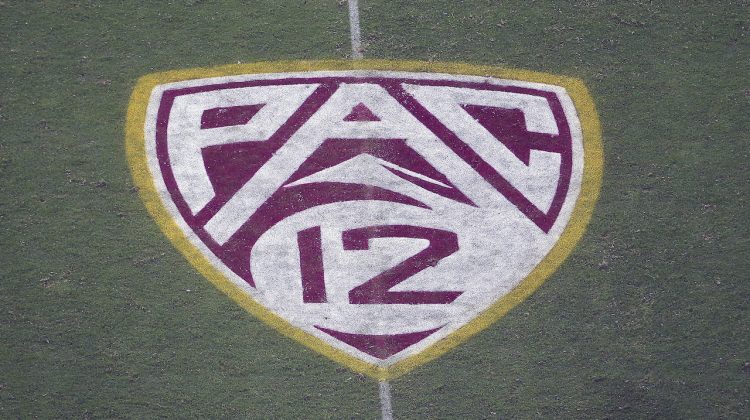The morning after, devastation.
“Gut-wrenching stuff,” one Pac-12 administrator noted.
“So damn sad,” offered another.
The 108-year-old conference, which produced sports luminaries ranging from Kareem Abdul-Jabbar and John Elway to Annika Sörenstam, Phil Mickelson, Jackie Joyner-Kersee, Reggie Bush, Karch Kiraly, Sabrina Ionescu and Barry Bonds — not to mention a second baseman named Jack Roosevelt Robinson — will cease to exist next summer, at least in any recognizable form.
Eight of the existing schools will join other conferences following a mass exodus on a surreal Friday that changed the college sports landscape forever.
USC, UCLA, Oregon and Washington are headed to the Big Ten.
Arizona, Arizona State, Utah and Colorado are departing for the Big 12.
Only Stanford, Cal, Washington State and Oregon State remain — if they choose to hang around.
The Pac-4 cannot exist. The conference would need at least two more schools to reach the membership requirements set by the NCAA. Plans will evolve over the coming days and weeks. Eulogies will be offered through the spring, for a full season of competition awaits all 12 schools.
For now, let’s address the T-Rex in the room: How in the name of Bill Walton did this happen?
The collapse occurred over a 12-hour stretch on Friday but was, in fact, 12 years in the making — 12 years of strategic miscalculations, 12 years of presidential arrogance, 12 years of missed opportunities, 12 years of wounds at once self-inflected and thrust upon the conference from afar.
Commissioner George Kliavkoff bears immense responsibility for the collapse, but not all of it. Not close to all of it.
Here’s a 12-step path to destruction that began early last decade and continued through the extinction event this week.
1. The Tier 1 contract.
In the spring of 2011, then-commissioner Larry Scott signed a groundbreaking, $3 billion contract with Fox and ESPN to televise the Pac-12’s top football and men’s basketball games (i.e., Tier 1 broadcast rights). There was only one problem: The deal spanned 12 years and had no escape clause late in the term, according to a source. The Pac-12 was locked in until 2024, which proved to be two years too late.
2. The Pac-12 Networks
After signing with ESPN and Fox, Scott received approval to create a media company fully owned by the schools, complete with first-rate production, one national network and six regional feeds. But in expanse and expense, the Pac-12 Networks far exceeded the value of the content they delivered. The result was an ongoing struggle for distribution and revenue that would hinder the schools for 12 years. The greatest whiff, of course, was the lack of distribution on DirecTV — a fatal flaw rooted in the business model: DTV was willing to partner with the Pac-12, but at a cheaper price than other carriers paid. Because of the so-called ‘Most Favored Nations’ clause in the distribution contracts, Scott would have been forced to drop the subscription price for every partner if he lowered the number with DTV, thereby wrecking what slim profits existed.
3. Outflanked by the Big Ten
In the spring of 2016, Big Ten commissioner Jim Delany finalized a new media rights contract that was surprisingly short in duration. It expired after just six years, in the summer of 2023 — one year before the end of the Pac-12’s agreement with ESPN and Fox. That allowed the Big Ten to beat the Pac-12 back into the market and, eventually, dangle an offer in front of USC and UCLA.
4. Scott’s losing scorecard
In July 2018, following a disastrous bowl season for the Pac-12, Scott addressed reporters and brushed aside the results on the field. “The scorecard we think matters … is academic and athletic success across all sports,” he said. The comment exemplifies the ethos, shared by Scott and the presidents, that Olympic sports were as important as football. However inspiring and high-minded, the approach had zero basis in reality on the front lines of college athletics. Scott should have been all about football, all the time.
5. Refusing ESPN’s offer
In late 2018, ESPN approached Scott and offered to take over distribution of the Pac-12 Networks and sign the conference to a long-haul Tier 1 media deal, according a report in the Sports Business Journal several months after the fact. Scott and the presidents declined the lifeboat, preferring instead to maintain full control of the struggling networks under the presumption that they would be worth a fortune when the distribution contract cycle expired in 2024. Had the conference linked arms with ESPN back then, the resulting long-term contract would not have offered USC and UCLA an escape hatch to the Big Ten.
6. Rejecting expansion
The summer of 2021 was telling. Had the Pac-12 presidents agreed to expand as desperate Big 12 schools pleaded for salvation, the conference would have been fortified against the L.A. thunderbolt that struck a year later. (Houston, from the American conference, was also available.) But the presidents passed after determining none of the available schools were good fits competitively, financially and institutionally. Given new life, the Big 12 stabilized, grew and positioned itself for long-term survival — at the Pac-12’s ultimate expense.
7. The USC piece
During his first year on the job, Kliavkoff asked USC president Carol Folt several times if the Trojans were committed to the conference and always received an affirmative response, according to multiple sources. But did he do everything possible to keep them happy? Should the presidents have agreed to unequal revenue shares? And even if the conference office had rented space in Heritage Hall, would it have prevented USC’s departure given the money and platform available in the Big Ten?
8. The Fox mess
Kliavkoff entered the media negotiations last summer with a leverage issue: One of the Pac-12’s longtime partners, Fox, had little interest in taking a substantial stake in the conference. Why? Because it owns the Big Ten’s media rights and secured access to the massive L.A. market by gobbling up USC and UCLA. (At the same time, Fox was compelled to renew its deal with the Big 12 in order to preserve access to the state of Texas.) One year later, Fox finished the job, mustering enough cash to grab Oregon and Washington. In our view, no external entity played a greater role in the Pac-12’s demise.
9. Missed messaging
Long before he lost the conference, Kliavkoff lost the narrative. His decision to stay radio silent for months on end despite so much negative messaging — much of it emanating from Big 12 country — allowed the noise to build across the Pac-12 footprint. Eventually, public trust and confidence eroded. University presidents and athletic directors don’t spend every minute sequestered in offices. They interact with fans and donors all the time and are susceptible to public furor. As the months passed and the noise increased, internal faith in Kliavkoff’s process shriveled. The PR issue carried less importance than many others on this list, but it shouldn’t be ignored.
10. Urgency: MIA
The Hotline addressed this matter in January, devoting an entire column to the risks associated with Kliavkoff’s view that there was “no need for a rush” to complete the media rights deal. His entire strategy hinged on the presidents staying patient and external forces remaining at bay. Specifically, we wrote the following: “In realignment, presumptions are the kindling for crisis; confidence is the agent of destruction. Kliavkoff needs to get a deal done sooner than later. ‘If you slow-play it,’ the source said, ‘you become vulnerable to the unknowns.’ … What if Fox changes its strategy and decides ‘Big Ten West’ has a nice ring to it? What if the Arizona and Mountain schools grow anxious and opt for security in the Big 12?” Kliavkoff was unable to seal the deal during the prolonged stretch of solitude in the Big Ten. When he finally tried to complete the process, the Pac-12 greatest existential threat had awoken.
1. The Tier 1 contract.
In the spring of 2011, then-commissioner Larry Scott signed a groundbreaking, $3 billion contract with Fox and ESPN to televise the Pac-12’s top football and men’s basketball games (i.e., Tier 1 broadcast rights). There was only one problem: The deal spanned 12 years and had no escape clause late in the term, according to a source. The Pac-12 was locked in until 2024, which proved to be two years too late.
2. The Pac-12 Networks
After signing with ESPN and Fox, Scott received approval to create a media company fully owned by the schools, complete with first-rate production, one national network and six regional feeds. But in expanse and expense, the Pac-12 Networks far exceeded the value of the content they delivered. The result was an ongoing struggle for distribution and revenue that would hinder the schools for 12 years. The greatest whiff, of course, was the lack of distribution on DirecTV — a fatal flaw rooted in the business model: DTV was willing to partner with the Pac-12, but at a cheaper price than other carriers paid. Because of the so-called ‘Most Favored Nations’ clause in the distribution contracts, Scott would have been forced to drop the subscription price for every partner if he lowered the number with DTV, thereby wrecking what slim profits existed.
3. Outflanked by the Big Ten
In the spring of 2016, Big Ten commissioner Jim Delany finalized a new media rights contract that was surprisingly short in duration. It expired after just six years, in the summer of 2023 — one year before the end of the Pac-12’s agreement with ESPN and Fox. That allowed the Big Ten to beat the Pac-12 back into the market and, eventually, dangle an offer in front of USC and UCLA.
4. Scott’s losing scorecard
In July 2018, following a disastrous bowl season for the Pac-12, Scott addressed reporters and brushed aside the results on the field. “The scorecard we think matters … is academic and athletic success across all sports,” he said. The comment exemplifies the ethos, shared by Scott and the presidents, that Olympic sports were as important as football. However inspiring and high-minded, the approach had zero basis in reality on the front lines of college athletics. Scott should have been all about football, all the time.
5. Refusing ESPN’s offer
In late 2018, ESPN approached Scott and offered to take over distribution of the Pac-12 Networks and sign the conference to a long-haul Tier 1 media deal, according a report in the Sports Business Journal several months after the fact. Scott and the presidents declined the lifeboat, preferring instead to maintain full control of the struggling networks under the presumption that they would be worth a fortune when the distribution contract cycle expired in 2024. Had the conference linked arms with ESPN back then, the resulting long-term contract would not have offered USC and UCLA an escape hatch to the Big Ten.
6. Rejecting expansion
The summer of 2021 was telling. Had the Pac-12 presidents agreed to expand as desperate Big 12 schools pleaded for salvation, the conference would have been fortified against the L.A. thunderbolt that struck a year later. (Houston, from the American conference, was also available.) But the presidents passed after determining none of the available schools were good fits competitively, financially and institutionally. Given new life, the Big 12 stabilized, grew and positioned itself for long-term survival — at the Pac-12’s ultimate expense.
7. The USC piece
During his first year on the job, Kliavkoff asked USC president Carol Folt several times if the Trojans were committed to the conference and always received an affirmative response, according to multiple sources. But did he do everything possible to keep them happy? Should the presidents have agreed to unequal revenue shares? And even if the conference office had rented space in Heritage Hall, would it have prevented USC’s departure given the money and platform available in the Big Ten?
8. The Fox mess
Kliavkoff entered the media negotiations last summer with a leverage issue: One of the Pac-12’s longtime partners, Fox, had little interest in taking a substantial stake in the conference. Why? Because it owns the Big Ten’s media rights and secured access to the massive L.A. market by gobbling up USC and UCLA. (At the same time, Fox was compelled to renew its deal with the Big 12 in order to preserve access to the state of Texas.) One year later, Fox finished the job, mustering enough cash to grab Oregon and Washington. In our view, no external entity played a greater role in the Pac-12’s demise.
9. Missed messaging
Long before he lost the conference, Kliavkoff lost the narrative. His decision to stay radio silent for months on end despite so much negative messaging — much of it emanating from Big 12 country — allowed the noise to build across the Pac-12 footprint. Eventually, public trust and confidence eroded. University presidents and athletic directors don’t spend every minute sequestered in offices. They interact with fans and donors all the time and are susceptible to public furor. As the months passed and the noise increased, internal faith in Kliavkoff’s process shriveled. The PR issue carried less importance than many others on this list, but it shouldn’t be ignored.
10. Urgency: MIA
The Hotline addressed this matter in January, devoting an entire column to the risks associated with Kliavkoff’s view that there was “no need for a rush” to complete the media rights deal. His entire strategy hinged on the presidents staying patient and external forces remaining at bay. Specifically, we wrote the following: “In realignment, presumptions are the kindling for crisis; confidence is the agent of destruction. Kliavkoff needs to get a deal done sooner than later. ‘If you slow-play it,’ the source said, ‘you become vulnerable to the unknowns.’ … What if Fox changes its strategy and decides ‘Big Ten West’ has a nice ring to it? What if the Arizona and Mountain schools grow anxious and opt for security in the Big 12?” Kliavkoff was unable to seal the deal during the prolonged stretch of solitude in the Big Ten. When he finally tried to complete the process, the Pac-12 greatest existential threat had awoken.
11. Echoes of past gaffes, part I
It appears the Pac-12 repeated its failed strategy from the early 2010s, when Scott overestimated the value of his content and spearheaded the move to own 100 percent of the Pac-12 Networks, rather than partnering with an established company. This time around, Kliavkoff and his adviser, Doug Perlman, set a high initial bar at the negotiating table. How high? We don’t know the details of their offer, what impact that asking price had on relationships or what role UCLA’s status played. (At the time, its move hadn’t been approved by the UC regents.) But we know a deal didn’t materialize until many, many months later.
12. Echoes of past gaffes, part II
Let’s start this section with a caveat: The specifics of the incentive clauses in the Apple contract proposal remain hidden, but we know they existed. And if you’re aware of the original sin of the Scott era, you can probably guess there was some unease when Kliavkoff unveiled the official deal this week. A dozen years ago, Scott sold the schools on a Pac-12 Networks revenue model that was hooked to hitting distribution goals. Now here was Kliavkoff, presenting an Apple deal in which a portion of the revenue was tied to subscription goals.
Was that the deal-breaker, the singular force that wrecked the Pac-12? Nope.
One issue cannot obliterate a storied, 108-year-old conference. Destruction unfolded over many years and took many forms. It’s as complicated as the end was swift.
Related posts:
 Wilner Hotline – Pac-12 on the brink: USC and UCLA expected to seek membership in the Big Ten
Wilner Hotline – Pac-12 on the brink: USC and UCLA expected to seek membership in the Big Ten  Pac-12 survival: What to make of Big Ten expansion plans, Oregon’s search for an escape hatch and the Big 12 option
Pac-12 survival: What to make of Big Ten expansion plans, Oregon’s search for an escape hatch and the Big 12 option  Pac-12 survival: Why the conference should follow the CFP’s lead and expand
Pac-12 survival: Why the conference should follow the CFP’s lead and expand 
Washington State quarterback Cameron Ward (1) (AP Photo/Andy Manis)
Wilner Hotline – Saturday Night Five: Along come the Cougars, OSU’s big win, USC’s takeaways, collecting wins (except in Boulder)
